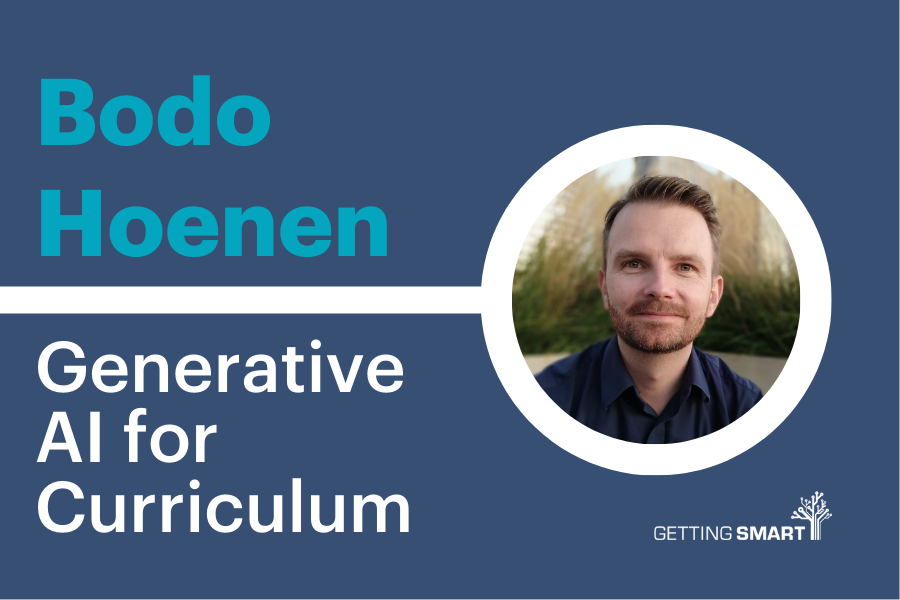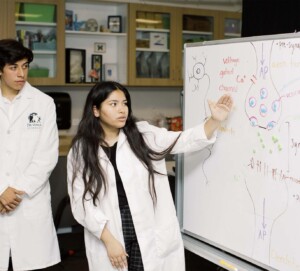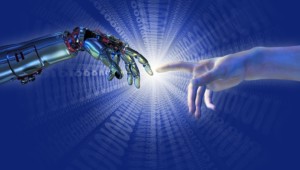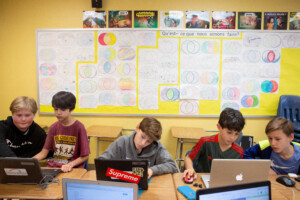Bodo Hoenen on Generative AI For Curriculum
Key Points
-
AI will radically empower educators to spend more quality time with learners.
-
One of the best ways to demonstrate mastery is to teach the subject to two of their friends. This both shows mastery and propagates further learning in the community.
-
Collective intelligence is a crucial part of how humans learn.

This episode is supported by our recent Artificial Intelligence publication which focuses on the ways in which AI is shaping teaching, leading and learning.
On this episode of the Getting Smart Podcast, Nate McClennen is joined by Bodo Hoeden co-founder and CEO of Nolej, a generative AI tool that automatically converts documents (Text, Video, Audio) into dynamic active learning content through the use of our AI. What used to take instructional designers hours, can now be done by anyone in minutes.
Nolej is focused on doing the following:
- Creating a tool that can generate bite-sized e-learning packages from any content in real-time.
- Mapping these experiences into a multi-dimensional latent space – almost like a map of ignorance for search and visibility.
- Building a GPS to help guide you through these learning experiences and to help you interact with mentors, experts and other learners.
In this conversation, Nate and Bodo discuss the vast potential of AI, the past and future of collective intelligence, the ‘map of ignorance,’ the structure of Nolej and much more.
Nate McClennen: Welcome, everybody. You’re listening to the Getting Smart podcast. I’m Nate McClennen, and it feels like AI is suddenly what everybody’s talking about. Although AI has been in use for a number of years, the recent ease of use has educators now considering its impact. Some of us are curious, some are scared, and some are just wondering how to grasp it all. While schools and districts initially react by shutting it down, we’re likely at the height of an innovation curve. There’s no doubt that it’s here, and the next five years will see massive acceleration and impact in this space. Positives—like we’ll hear about today—include increased personalization for every learner and efficiencies that free up teacher time to focus on uniquely human tasks like local learning, building strong relationships, and mentorship. This could make teaching a more sustainable and desirable profession. On the downside, AI tools will also drive an industry that seeks to deceive and manipulate, making the discernment of truth a critical skill. Maybe this will bring us back to face-to-face conversations as the only way to truly determine if something is real, which might be good for the planet.
Today, we’re diving into a solution that uses AI to increase efficiency for educators, personalize learning, and eventually allow every learner to use AI to design a unique path to understanding. I’m excited to have Bodo Hoenen on the podcast today. He’s the co-founder and CEO of Knowledge IO, and a collective intelligence scientist. Bodo and I have spoken a few times, and I’m thrilled to have you here. Welcome, Bodo.
Bodo Hoenen: Yeah, thank you for having me. Really excited.
Nate McClennen: So, I’m excited too, and my first question, because I love the job description, is: What on earth is a collective intelligence scientist? How do you describe that to people?
Bodo Hoenen: It’s all about tapping into the intelligence of those around us to enhance our own learning. It started about ten years ago with a focus on working in environments without traditional educators, like refugee camps or slums in East Africa, where children lack formal educators or parental encouragement to learn. The question was, how do we empower them to actually learn? My approach was to use the collective intelligence of children and the community around them to rapidly learn from each other, and that’s where it began. It’s really about making learning possible by leveraging the knowledge around us.
Nate McClennen: It seems like communities have always learned from each other—collective intelligence isn’t new. Has our education system moved away from that? Why is this approach novel, and how is AI a game-changer for this before we dive into what Knowledge IO is doing?
Bodo Hoenen: The novelty with collective intelligence is that it allows almost anyone in your network to serve as a mentor, teacher, or someone who can teach you something. Vice versa, you could be a mentor or teacher to someone else in your network. This concept changes how we view education, making it more like the way we learn before and after school—outside the traditional “sage on the stage” model where one person teaches and everyone else listens. Collective intelligence lets us think differently about how education looks and works.
Nate McClennen: Isn’t that interesting? We go to school to prepare for the real world, yet school itself isn’t like the real world, which is based on collective intelligence—a human condition. Let’s dive into Knowledge IO, spelled N-O-L-E-J. When I first heard about it and we started talking, I was excited. Give us the big picture of what Knowledge IO does and what it’s doing now on the ground.
Bodo Hoenen: To understand the big picture, let’s start with the problem we’re trying to solve. Most jobs our school systems are preparing students for may be obsolete by the time they graduate. The content in many courses is irrelevant to students’ current needs, meaning that by the time they need the knowledge, they may have forgotten it. How many of us remember what we learned last semester, let alone last year? This makes traditional education inefficient. Right now, we can’t adapt fast enough, as creating new courses takes months or years. But what if we could learn in real-time as needs arise?
To solve this, I’ve experimented as a collective intelligence scientist and concluded that we need three components:
- A tool that converts any information into bite-sized e-learning packages, ready to learn from and updated in real time.
- A map, like Google Maps for learning, that organizes all these bite-sized components in a multidimensional “latent space.” This allows anyone—learners, educators, curriculum designers, employers—to navigate and access what they need efficiently.
- A GPS system that guides users through this space, connecting them not only to content but also to experts and mentors for a more comprehensive learning experience.
Nate McClennen: I see. So the first component is about managing the exponential growth of information by creating accessible learning. How is this different from Googling or watching a YouTube video?
Bodo Hoenen: Good question. If you Google something, you’ll sift through results to find something useful, and with traditional educational sites, like Coursera or LinkedIn, it’s hard to know if a course will fit your needs. About 80% of the content may not be relevant. We need a system that chunks information into micro-learning packages, making it searchable and specific to the user’s needs. That’s what our tool does: it quickly breaks down information into bite-sized components ready for learning.
Nate McClennen: That makes total sense. I tested this tool myself this morning with a white paper we published on micro-schools. I uploaded the PDF, and within minutes, it was summarized with different types of questions just as you described. Since it’s not magic, can you explain what’s happening behind the scenes?
Bodo Hoenen: We use multiple models, but the process mirrors the workflow of an instructional designer. The system “reads” the document, identifies key ideas, extracts definitions, and generates quiz questions, flashcards, and interactive components. In the background, several models work together to analyze the content and produce the output just like an instructional designer would.
Nate McClennen: And just to clarify, these models aren’t sentient or “thinking”—they’re large datasets generating likely answers based on inputs, correct?
Bodo Hoenen: Absolutely. What’s unique about our model, compared to something like ChatGPT, is that we base the content generation on the document provided, ensuring it’s accurate and not prone to “hallucinations” or inaccuracies.
Nate McClennen: That’s a good distinction. ChatGPT and similar models are getting a lot of attention, but your approach is different. You also mentioned a verification process for output quality. Can you share more about that?
Bodo Hoenen: Sure. We run a Turing test where instructional designers assess whether modules are human- or AI-generated. A few months ago, about 60% of them thought our AI-generated content was human-created, but now we’re at about 85%. We’re always improving, but I believe we’ll still need educators to validate and personalize content for their learners.
Nate McClennen: That’s reassuring to hear, especially with concerns that AI might replace teachers. But it sounds like AI frees up time for teachers to focus on what they do best—teaching and building relationships.
Bodo Hoenen: Exactly. In my collective intelligence work, I found that about 20% of learning comes from content, while the other 80% comes from interactions with others. This tool aims to handle the content so teachers can focus on engaging with students and facilitating deeper learning.
Nate McClennen: I can see that. With more self-directed, project-based learning in schools, tools like yours can streamline the preparation process, allowing students and teachers to focus on real-world impact. So right now, people can try out the first phase—Knowledge AI for designing instructional materials. But I’m fascinated by the third phase, the Knowledge Protocol, which uses collective intelligence. Can you explain that?
Bodo Hoenen: The Knowledge Protocol came from my work in refugee camps, where formal assessments didn’t make sense. Instead, we created a system where learners earned points through interactions. To “prove” mastery, they would teach what they learned to others. This approach deepened their understanding and spread knowledge through the community efficiently. For Knowledge IO, we’ve adapted this to a digital protocol, where learners demonstrate knowledge by teaching peers. It’s collective intelligence in action—everyone can be a learner and a teacher, sharing expertise across the network.
Nate McClennen: So it’s not just about relying on experts; it’s creating a community where learners support each other. That’s brilliant. Do you envision this happening solely online, or do you see in-person applications?
Bodo Hoenen: Both. For example, while building this technology, my daughter lost the use of her arms. We couldn’t afford the treatments, but we used Knowledge IO to research brain-controlled exoskeletons and connect with experts. In just seven months, we built an exoskeleton for her. This kind of learning happens both online and in-person. It’s dynamic, allowing learners to pursue their interests and real-world applications.
Nate McClennen: That’s an incredible story, Bodo. It really illustrates how collective intelligence and technology can lead to transformative outcomes. With that example, it’s clear that Knowledge IO has the potential to support learners in solving real-world challenges and creating tangible impact. How do you see this kind of self-directed learning approach scaling in traditional education systems? Schools and institutions often have set curricula and standards that they need to follow.
Bodo Hoenen: That’s a great question, Nate. I think the key is to integrate this approach into existing systems as a supplemental tool rather than trying to replace what’s already there. For instance, students could use Knowledge IO to explore interests more deeply or to create learning paths that go beyond the standard curriculum. It can help schools provide personalized learning experiences that are difficult to achieve with traditional resources alone. By allowing students to engage with content that resonates with them, schools can make learning more relevant without completely overhauling their curriculum.
What’s exciting about Knowledge IO is that it can flexibly fit into many different educational contexts, from traditional classrooms to homeschooling to self-directed learning environments. Teachers can use it to supplement their instruction, or students can use it independently to pursue topics they’re passionate about. The idea is to empower both educators and students to take control of their learning journey in a way that complements the structure of formal education.
Nate McClennen: So, in a way, it’s about adding depth and adaptability to the current system rather than trying to change everything all at once. I think that approach could be very appealing to schools that want to innovate but might be hesitant to make sweeping changes.
Bodo Hoenen: Exactly. We know that change in education often takes time, and we want to meet schools where they are. By offering a tool that enhances what they’re already doing, we can make it easier for educators to introduce personalized learning without having to reinvent the wheel. And as more educators and students see the benefits of this approach, it can naturally lead to a shift toward more self-directed and interest-driven learning over time.
Nate McClennen: Bodo, this has been a fascinating conversation. I’m inspired by what you’re doing with Knowledge IO and by your commitment to making learning more accessible, personalized, and impactful. For educators or learners who are interested in getting started with Knowledge IO, what’s the best way for them to dive in?
Bodo Hoenen: Thank you, Nate. For anyone interested, they can visit our website and try out the Knowledge IO tool. Right now, we’re focusing on the first phase, which is Knowledge AI, where they can upload documents, like PDFs or articles, and see the tool break them down into bite-sized learning components. We’re also looking for feedback from users, as it helps us improve the system and understand what educators and learners need. We’re excited to engage with the community and to keep building out the tool in ways that support both traditional and innovative learning environments.
Nate McClennen: That’s fantastic. I know that many educators are curious about how AI can support learning, and it sounds like Knowledge IO offers a practical, hands-on way to explore that potential. Bodo, thank you for joining us today and for sharing your insights and your vision for the future of learning.
Bodo Hoenen: Thank you, Nate. It’s been a pleasure, and I’m looking forward to seeing how Knowledge IO can make a difference for educators and learners alike.
Nate McClennen: Thank you to our listeners for tuning into this episode of the Getting Smart podcast. Until next time, keep learning, keep innovating, and keep exploring the possibilities that technology and collective intelligence can bring to education.
Links:








0 Comments
Leave a Comment
Your email address will not be published. All fields are required.